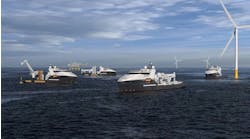A new player has entered the heavy-lift transport sector - Sealift. The company plans to operate six identical vessels. The first two should come on the market this year, with at least two more to follow early in 2008.
Sealift is registered in Bermuda and managed out of the Netherlands, but the company has its origins in Oslo-based tanker operator, Frontline. The company launched Sealift last year and in January raised $180 million in equity for the new company through an over-subscribed private placement. Having put in $60 million itself, it now holds a 33% stake.
Frontline has provided six Suezmax vessels for the Sealift fleet and is financing their conversion to semisubmersible heavy-lift units. Sealift will pay $100 million for each vessel, the first of which is being converted. In the period before the second, third, and fourth vessels go into the yard to be converted, they are being bareboat-chartered back to Frontline at a rate of $15,000 a day.
All the vessels are 149,999-dwt sisterships and will be converted at Cosco’s Nantong and Zhoushan shipyards in China. The first, 1992-builtFront Sunda, is due to be delivered in May. The vessel will be renamed Sealift Transporter. It will be followed by Sealift Mover in October, and Sealift Traveller and Sealift Comor both in Jan. 2008.
Artist’s impression of the Sealift heavy-lift transport vessel. The fleet will consist of six identical vessels.
This fleet of identical vessels will position Sealift as a leading force in the market. The conversions involve retaining the fore and aft sections of the original ships and installing a new cargo deck between them. The deck loading capacity will be 20 metric tons/sq m (22 tons/sq ft), which, given the cargo deck area of 130 m x 44.5 m (426.5 ft x 146 ft), will create a load carrying capacity of around 54,000 metric tons (59,525 tons) - among the highest capacity available in heavy-lift vessels.
The main engine will be retained and upgraded, and three new B&W Holeby diesel generators will be installed to help meet the power requirement, including driving the 1.5 MW Kawaskai bow thruster. Four new winches will be installed for cargo handling. Additional accommodation will be provided for 20 personnel.
The conversion is a major upgrade, giving the converted vessels in effect a five-year-old status. Design life in the new mode will be around 20 years.
To head the company, Bert Bekker, who recently retired as CEO of Dockwise, was appointed CEO. He has recruited an experienced team, including former Dockwise executive, Rob Boer.
“Sealift is very optimistic about the future heavy transport market,” Bekker says. “Demand is high, and we foresee a lot of opportunities in the near future, especially in the oil and gas industry.”
The oil and gas industry is the main driver of the market at present. The transport needs associated with the high numbers of drilling rig newbuildings is expected to keep demand strong for several years to come, along with a smaller number of floating production facilities. Most of the newbuild projects are based in the Far East, but many rigs are expected to be contracted for work in other parts of the world. Owners are likely to look preferentially to heavy-lift vessels to move their valuable assets - the price-tag for sixth-generation semisubmersibles is generally $600 million plus.
Attractive market prospects have encouraged other players to invest in the sector. Ocean Heavy Transport, set up by Norwegian shipping interests, will have four vessels active by October. Dutch tug and barge operator Fairmount is undertaking the conversion of two semisubmersible barges into heavy-lift ships, though these will have a carrying capacity well below that of the Sealift vessels.
Meanwhile, Dockwise, which previously dominated the heavy end of the market, is operating under new ownership - the 3i venture capital group. The fleet is for the most part over 20 years old, and the new owner has to consider whether to invest in new tonnage or upgrade existing vessels. Meanwhile, one of these, the semisubmersibleMighty Servant 3, is out of action until next year after it sank off Angola in December.
Against this background, Sealift favors a move toward consolidation in the market. “Consolidation means larger fleets and benefits the interests of clients with regard to fleet flexibility and scheduling,” Bekker says. This policy is shared by Frontline, which said in a statement earlier this year that as a major shareholder in Sealift it would use its influence to seek further consolidation in the heavy-lift market.
For Frontline, in addition to establishing a new business in a sector that has long interested it, the formation of Sealift provides a solution for single-hull tonnage which would eventually have to be phased out of crude oil transport. As Bjørn Sjaastad, CEO of Frontline Management, explains, “We have through the [Sealift] transaction proven that there is significant value enhancement in finding alternative use of single-hull tonnage.”





